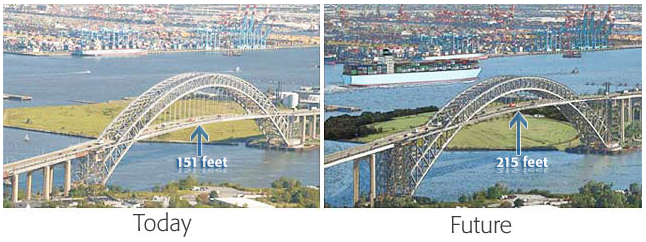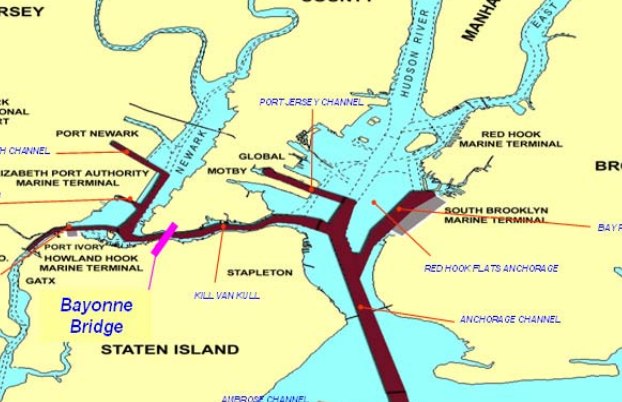
It seems that the Bayonne Bridge Navigational Clearance Program – the $1.4 billion dollar project that will raise the height of the bottom of the bridge span from 151 feet to 215 feet – has come under fire recently, primarily because of unclear prognostications about the project.
Last month, Coalition for Healthy Ports, along with two Staten Island-based organizations and the NRDC (the Coalition) filed a law suit questioning the Port Authority of New York and New Jersey’s (PANYNJ) assertions that the project will have a minimal impact on the overall volume of cargo handled by the Port of New York and New Jersey (PONYNJ). Of particular concern is the potential negative impact on air quality that might result if the impact is understated.

To understand the Coalition’s concerns, it is helpful to talk about the PANYNJ’s stated basis for the project.
The Bayonne Bridge connects Staten Island to New Jersey by passing over the Kill van Kull, the waterway that connects Newark Bay with New York Harbor. Currently, the bridge is 151 feet above the waterline – enough to handle most of the ships currently in the global fleet (called Panamax ships). However, with the ongoing expansion of the Panama Canal, ships are getting bigger (“Post-Panamax” ships) hence the need to increase the Bayonne Bridge’s clearance. If the bridge isn’t raised, the Port would stand to lose business; the majority of carriers said “they may need to bypass the Port of NY/NJ in the future if the Bayonne Bridge remains a restriction” because Post-Panamax ships “will be deployed on most relevant trade routes whether the Port of New York and New Jersey can accept them or not.”
Notwithstanding the stated need to raise the bridge, the environmental assessment ultimately concluded that with or without the project, business will remain approximately the same in terms of volume:
“Even under the most conservative case… the analysis demonstrates that the additional induced demand at terminals west of the Bayonne Bridge would be less than 0.7 percent of the 10.65 million TEUs [Twenty-Foot Equivalent Units, or shipping containers] expected in 2035. This additional demand results in a negligible increase in truck and rail traffic that would not be noticeable on an annual, daily or hourly basis.”
In other words, although PANYNJ has said several times that raising the bridge must be done to avoid losing a significant amount of business, whether or not the bridge is raised, the volume of cargo will remain almost constant.

The EA clearly contradicts both the stated reason for the project and PANYNJ’s past statements about the project. And this contradiction is important because if raising the bridge means a much higher shipping volume it could mean air quality will be impacted by more trucks on the road moving that cargo. The Coalition’s experts determined that although the EA determined the project will add up to 54 truck trips from the PONYNJ, using more realistic mode splits for hauling the cargo from the port and expected changes in volume based on past studies analyses, the project could add up to 2,450 – 10,390 truck trips/day.
The Coast Guard’s approval of an EA that does not explain this contradiction does not comport with NEPA requirements that these types of environmental impacts be fully explained and analyzed. This analysis must be done before the Coast Guard can sign off on the project.

No no no.
From what you wrote (I didn’t follow the links), you’re argument has faulty logic. The PA is saying that it will loose business if it doesn’t raise the bridge as the big ships (that will be replacing the smaller older Panamax ships) will go elsewhere that can accommodate the bigger post-Panamax ships. But if they do build it they will be able to continue to receive the new ships that will be replacing the old and they predict that they will only a fractional increase in shipping from the larger ships. The reason why this can be is simple. They will just receive less ships as the bigger ships can obviously carry the freight of 1.5, 2 or even 3 smaller ships.
Nowhere in your argument do you actually cite something that says that the freight traffic will remain the same if the bridge is not raised but that is exactly what the PA is saying.
Yes to the above. In addition, because the ships will be larger, cargo can be accommodated with fewer ships implying lessened ship-related emissions. This lobbying group just seems to reflexively against any project that comes up.
The Port of NY/NJ loses as a shipping destination to Baltimore and other locals simply because the biiger ship CAN’T come here.
Allowing the bigger ships will mean more freight rail traffic, more dock workers – in effect jobs and an economic boon to the region.
Shippers will not use 2 smaller ships instead of 1 big one just to have NY Harbor as a destination – increased cost is the reason.
Increase dtransportation means increased commerce which translates into dollars. It also means cheaper prices as transporting from Baltimore or other places would br greatly reduced o eliminated.
Look at it this way – would would New York City be if it were not for the subway? Not the metropolis it is now – that’s for sure.
You can be against the bridge raising all you want – you need to see the big economic picture. It is also an effective reuse of the bridge without having to start from scratch.
Sort of sad. If the PA had been really serious about attracting post Panamax ships, it could have built a harbor tunnel for rail freight…from Jersy to Brooklyn, and upgraded the Brooklyn port…one of the best ports on the eastern seaboard.The result would have been removal of trucks on the highways – Gowanus – I 95 etc. Less air pollution, less truck traffic, better roads that are not being banged up by trucks…
Yes we need freight rail tunnels but I believe the trucking firms and those moving goods to and from trucks do not want that…
Environmentally for both Peak Oil and Climate Change reasons that is the way to go…
Of course the other question is why LightRail is not placed on the new bridge…
Once fracking shale oil dropss off in 3-5 years we will go broke running cars and trucks while the rest of the World is seriously going with Green Transit
If the TSTC were pro transportation/pro rail freight, they would be spearheading a lawsuit against the Tappan Zee Bridge project for illegally not having its EIS consider the lower deck option with freight rail.
That this occurred was for the sole benefit of a few princess atop a pea types in Nyack whose wealth got their way- and one can’t find much of anything about these people that subvert transportation planning.
http://cos-mobile.blogspot.com/2013/03/e-groups-throw-in-towel-on-tpz.html
So telling about TSTC and Riverkeeper.